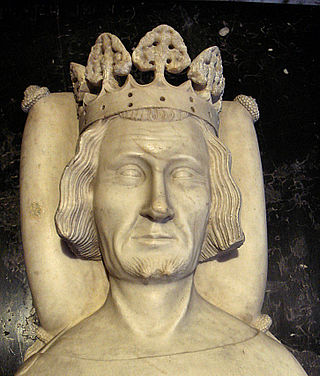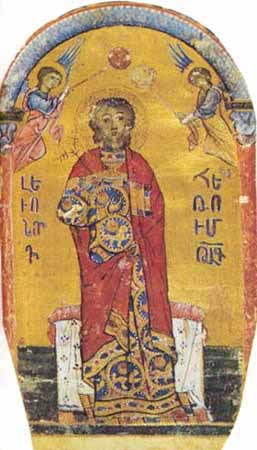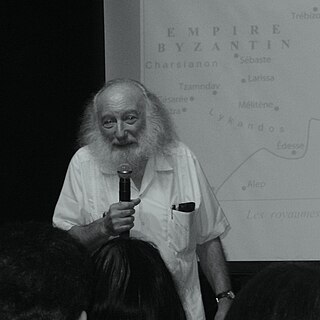Related Research Articles

Leo V or Levon V, of the House of Lusignan, was the last Latin king of the Armenian Kingdom of Cilicia. He ruled from 1374 to 1375.
Marie of Korikos served as the queen consort of Armenia from 1344–1363 and 1365–1373 through marriage to the kings Constantine III and Constantine IV, respectively.

Leo IV or Leon IV was the last Hethumid king of Cilicia, ruling from 1320 until his death. He was the son of Oshin of Armenia and Isabel of Korikos, and came to the throne on the death of his father. His name is sometimes spelled as Leo or Leon.

Hethum I ruled the Armenian Kingdom of Cilicia from 1226 to 1270. He was the son of Constantine of Baberon and Princess Alix Pahlavouni of Lampron and was the founder of the dynasty which bears his name: the Hethumids also known as the House of Lampron. Having accepted the suzerainty of the Mongol Empire, Hethum himself traveled to the Mongol court in Karakorum, Mongolia, a famous account of which is given by Hethum's companion, the historian Kirakos Gandzaketsi, in his History of Armenia. He allied with the Mongols to fight against the Muslim Mamluks and also encouraged other Crusader states to do the same.

Leo II or Leon II was king of the Armenian Kingdom of Cilicia, ruling from 1269/1270 to 1289. He was the son of King Hetoum I and Queen Isabella and was a member of the House of Lampron.

Hethum II, also known by several other romanizations, was king of the Armenian Kingdom of Cilicia, ruling from 1289 to 1293, 1295 to 1296 and 1299 to 1303, while Armenia was a subject state of the Mongol Empire. He abdicated twice in order to take vows in the Franciscan order, while still remaining the power behind the throne as "Grand Baron of Armenia" and later as Regent for his nephew. He was the son of Leo II of Armenia and Kyranna de Lampron, and was part of the Hethumid dynasty, being the grandson of Hethum I, who had originally submitted Cilicia to the Mongols in 1247. He was assassinated with his nephew and successor Leo III by the Mongol general Bilarghu, who himself was later executed for this by the Mongol Ilkhan ruler Öljaitü.

Oshin was king of the Armenian Kingdom of Cilicia, ruling from 1307 to 1320. He was a member of the House of Lampron, the son of Leo II, King of Armenia and Queen Keran.

The Hethumids, also known as the House of Lampron, were an Armenian dynasty and the rulers of the Armenian Kingdom of Cilicia from 1226 to 1341. Hethum I, the first of the Hethumids, came to power when he married Queen Isabella of Armenia who had inherited the throne from her father.

Hayton of Corycus was a medieval Armenian nobleman, monk and historiographer.
Constantine of Baberon was a powerful Armenian noble of the Het‛umid family. He was the son of Vassag and the father of King Het‛um I, who ruled the Armenian Kingdom of Cilicia from 1226 to 1270. Constantine played a pivotal role in placing his son on the throne by engineering the murder of Philip, the husband of Isabella, Queen of Armenia. He tricked Philip's father, Bohemond IV of Antioch, to search for his son at Amouda rather than at Sis, where he was being tortured and poisoned. He then took his army to the gates of Silifke Castle, forced its Frankish lords to surrender Isabella, and arranged the marriage, making his son the first Het‛umid ruler of the Armenian Kingdom.

Sempad the Constable (1208–1276) was a noble in Cilician Armenia, an older brother of King Hetoum I. He was an important figure in Cilicia, acting as a diplomat, judge, and military officer, holding the title of Constable or Sparapet, supreme commander of the Armenian armed forces. He was also a writer and translator, especially known for providing translations of various legal codes, and the creation of an important account of Cilician history, the Chronique du Royaume de Petite Armenie. He organized and fought in multiple battles, such as the Battle of Mari, and was trusted by his brother King Hetoum to be a key negotiator with the Mongol Empire.

The Battle of Mari, also called the Disaster of Mari, was a battle between the Mamluk Sultanate of Egypt and the Armenians of Cilician Armenia on 24 August 1266.

Armen (Claude) Z. Moutafian is a French mathematician and a historian who specializes in Armenian history. He is a Foreign Member of Armenian Academy of Sciences. He is the son of Zareh Mutafian.
Philippa of Armenia was an Empress of Nicaea. She was a daughter of Ruben III of Armenia and Isabella of Toron. Her maternal grandparents were Humphrey III of Toron and Stephanie of Milly.
Bilarghu, also Pilargh'ou, was a Mongol general of the ruler Ghazan during the end of the 13th and the beginning of the 14th century.
Joan of Taranto was Queen of Armenia by marriage to Oshin, King of Armenia. As daughter of Philip I, Prince of Taranto, she was a member of the Capetian House of Anjou.
Alice of Korikos was Queen of Armenia by marriage to Leo IV, King of Armenia. She was the only daughter of Oshin of Korikos and his first wife Margaret of Ibelin.
Alice of Armenia was ruling Lady of Toron from 1229 to 1234 as the eldest daughter of Ruben III, Prince of Armenia and his wife Isabella of Toron. She was heiress of Toron as well as a claimant to the throne of Armenia. She married three times; by her second marriage she was Countess of Tripoli, and she only had children from this marriage.

Mongol Armenia or Ilkhanid Armenia refers to the period in which both Armenia and the Armenian Kingdom of Cilicia became tributary and vassal to the Mongol Empire in the 1230s. Armenia and Cilicia remained under Mongol influence until around 1335.
References
- "Le Royaume Armenien de Cilicie", Claude Mutafian, Editions CNRS, Paris, ISBN 2-271-05105-3